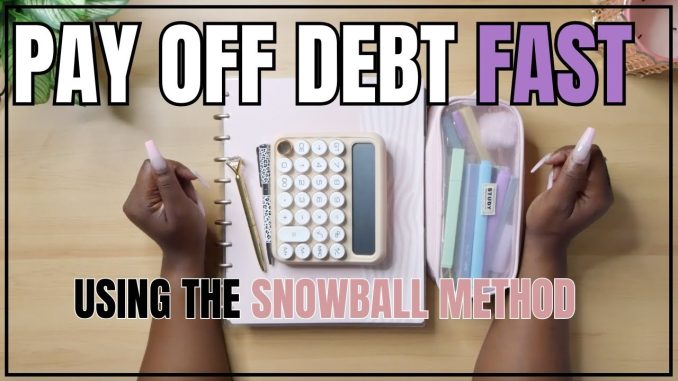
In the journey toward financial freedom, few obstacles loom as large and daunting as consumer debt. The weight of multiple loans, credit card balances, and personal liabilities can feel overwhelming, sapping motivation and delaying crucial life goals. While various strategies exist for debt repayment, one method has gained significant traction for its psychological efficacy and consistent success: the Debt Snowball Method. Far from being a purely mathematical approach, the snowball method leverages human behavior to build momentum and maintain motivation, ultimately helping individuals shed their debt faster and more effectively. Understanding its principles and applying its steps can transform a seemingly insurmountable challenge into a series of achievable victories, leading to a debt-free future.
At its core, the Debt Snowball Method involves listing all your debts from the smallest balance to the largest, regardless of their interest rates. The crucial distinction here is that it prioritizes psychological wins over purely economic optimization. While a mathematically driven approach like the Debt Avalanche Method (which targets highest interest rates first) might save slightly more on interest over time, the snowball method focuses on building momentum and confidence, which for many, proves to be the more sustainable path to debt eradication. It’s about cultivating the discipline and celebrating the small victories that keep you engaged in the long fight against debt.
The first step in implementing the Debt Snowball Method is to meticulously list all your debts. This means every credit card balance, personal loan, medical bill, and any other non-mortgage debt you owe. For each debt, record the creditor, the outstanding balance, and the minimum monthly payment. This comprehensive overview provides a clear, unvarnished picture of your total debt burden, laying the groundwork for your strategic attack. Knowing the enemy is the first step in defeating it.
Once listed, the next pivotal action is to order these debts from the smallest total balance to the largest. It is crucial to ignore the interest rates at this stage. For example, if you have a credit card with a ฿30,000 balance and a 20% interest rate, and a personal loan with a ฿20,000 balance and a 10% interest rate, the personal loan would come first in your snowball order because its balance is smaller. This counter-intuitive prioritization is central to the method’s psychological power.
With your debts ordered, the third step involves making the minimum payment on all debts except for the smallest one. On that smallest debt, you will dedicate every extra baht you can possibly find. This extra payment should come from cutting discretionary spending, earning additional income through a side hustle, or redirecting funds that might otherwise go towards savings (temporarily, until your initial debt-free foundation is solid). The goal is to funnel as much money as possible towards that smallest balance, attacking it with relentless focus.
The magic truly begins in the fourth step: once the smallest debt is completely paid off, you take the money you were paying on that debt (both the minimum payment and the extra amount) and add it to the minimum payment of the next smallest debt. This is where the “snowball” effect becomes apparent. The payment amount dedicated to the second debt is now larger than its original minimum, allowing you to pay it off faster. As each debt is eliminated, the payment amount you roll over to the next debt grows larger and larger, gaining momentum and speed, just like a snowball rolling downhill. This increasing velocity provides tangible proof of progress, fueling your motivation to continue.
Consider a practical illustration: Suppose you have four debts:
Credit Card A: ฿10,000 balance, ฿500 minimum payment
Personal Loan B: ฿25,000 balance, ฿1,000 minimum payment
Credit Card C: ฿40,000 balance, ฿1,500 minimum payment
Car Loan D: ฿100,000 balance, ฿2,500 minimum payment
If you identify an extra ฿2,000 per month you can apply to debt, you’d pay the minimums on B, C, and D, and direct ฿2,500 (฿500 minimum + ฿2,000 extra) towards Credit Card A. Once Credit Card A is paid off, you now have ฿2,500 freed up. You would then roll that entire ฿2,500 into Personal Loan B’s payment, making its new payment ฿3,500 (฿1,000 minimum + ฿2,500 rolled over). This accelerated payment dramatically shortens the time it takes to pay off Personal Loan B, and the process continues down your list.
The Debt Snowball Method is not just about numbers; it’s about behavior modification and psychological reinforcement. Each time a debt is paid off, you experience a significant emotional win. This feeling of accomplishment, of successfully conquering a financial burden, provides a powerful surge of motivation that makes you want to keep going. It transforms the daunting task of debt repayment into a series of achievable mini-goals, making the overall journey feel less overwhelming and more manageable.
While some financial purists might argue for the mathematical superiority of the avalanche method, which saves more interest by targeting the highest interest rates first, the real-world success stories of the snowball method lie in its ability to keep people engaged and committed. For many, the psychological wins generated by rapidly eliminating smaller debts are far more effective at preventing burnout and maintaining momentum than the abstract concept of saving interest. By embracing the Debt Snowball Method, individuals can systematically dismantle their debt burden, celebrating each victory along the way, and ultimately paving a clear path to financial freedom and peace of mind.